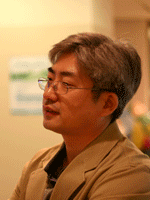
Prof. Sangho Koo
¢ÂAffiliation:
Department of Chemistry
Department of Energy Science and
Technology
Myongji University
Myongji-Ro 116, Cheoin-Gu, Yongin,
Gyeonggi-Do, 17058, Korea
ph)
+82-31-330-6185; Fax) +82-31-335-7248
E-mail) sangkoo@mju.ac.kr Home) http://www.kooslab.org
¢ÂEducation
1985: B.S. Seoul National University, Chemistry Major
1987: M.S.
The University
of Michigan, Organic Chemistry
1992: Ph. D. (Professor Masato
Koreeda), The University of Michigan, Organic Chemistry
1992 - 1994: Post-doctoral
Fellow Emory University
¢ÂProfessional
Career
1994.03~present: : Professor in chemistry, Myonji UniversityProfessor in Chemistry, Myongji University
2006.02~present: Special Visiting Professor, Chemical Biotechnology,
School of Pharmacy, East China University of
Science and Technology, Shanghai, China
2006.03~2013.02: Professor in Nano Science and Engineering, Myongji University
2013.03~present: Professor
in Energy Science and Technology, Myongji
University
2017.02~2021.01: Dean
of Natural Science, Myongji University
2019.01~present: Associate
Editor, Journal of the Korean Chemical
Society
2019.09~present: Guest
Professor, Institute of Traditional Chinese Medicine,
Tianjin University of Traditional Chinese Medicine, Tianjin,China
2020.01~present: Reginal Chairman of Korean Chemical Society in Gyeonggi Province
¢ÂResearch
Areas
|
1. Development of Efficient Cyclization Methods: Efficient synthetic methods for five-, six-, and seven-membered rings have been developed, and the syntheses of polycyclic structures using those compounds are under investigation. We are currently working on the Mn(III)-catalyzed oxidative hetero-aromatic cyclization for the syntheses of furan, pyrrole, indole, piperazinones. |
|
2. Chemistry of Isoprenoid: Isoprenoid can be classified into terpenoid, carotenoid, and steroid. We have developed various bi-functionalized C5 prenyl building blocks that can be efficiently used in the chain-extension processes for making various isoprenoid natural products. We adopted the Julia Sulfone protocol in C–C bond formation, which would give polyprenyl or polyene structures depending on the sulfone elimination process. Carotenoid natural products have been nicely assembled using our C10 bis(chloroallylic) sulfide, or C10 dialdehyde, or even C20 diphosphonate. We extended this strategy to make other important carotenoid compounds. We further pursue the synthesis of terpenoid and steroid compounds by the combined use of our cyclization and chain-extension strategies. Followings are the carotenoid compounds that we have made so far: Vitamin A, Vitamin K, Tretinoin, Isotretinoin, Tocoretinoate, b-carotene, Lycopene, Lycophyll, Nor-Bixin, Crocetin, Zeaxanthin, Astaxanthin, Canthaxanthin, Coenzyme Q-10, and Abscisic acid. |
|
3. Conducting Molecular Wires: Based on our methods of the carotenoid synthesis, we were able to construct the conjugated polyene chains with variable lengths. This conjugated polyene chains, which conduct electrons, can be stabilized by attaching phenyl substituents to the chain. We are preparing various organic conducting wires with different resistances. We are going to build up various molecular electronic circuits with diverse conductance |
|
4. Biomass conversion: Efficient conversion methods of sugars into useful platform chemicals such as 5-hydroxymethylfurfural (5-HMF) and 5-hydroxymethylpyrrole-2-carbaldehydes (pyrralines) are being investigated. A bis(sulfonic acid)-ionic liquid was utilized for fructose conversion to 5-HMF. The optimal condition using DMSO and oxalic acid transformed glucose and primary amines into pyrralines. This one-pot conversion of sugars into pyrralines is being applied to the total synthesis of biologically active natural products, (–)-Hanishin, Lobechine, and Magnolamide. Biomass conversion of ribose into sustainable platform chemicals as intermediates for new drug synthesis is underway |